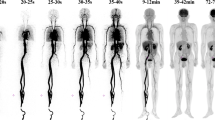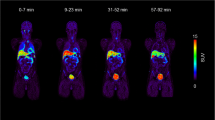Abstract
Objective
A planar positron imaging system (PPIS) enables whole-body dynamic imaging of radiopharmaceuticals labeled with positron-emitting nuclides. We evaluated the difference in the brain and whole-body pharmacokinetics of 11C-diphenylhydantoin (11C-DPH) between intravenous and duodenal administration in rats.
Methods
Male Wistar rats (8 weeks old, mean body weight 250 g) were examined under anesthesia. A tracer amount of 11C-DPH (2 μg or less; about 5 MBq) was injected into the tail vein (n = 3) or duodenum (n = 3). Immediately following the administration, PPIS scans were obtained for 20 min. Regions of interest (ROIs) were set on the brain, heart, liver, intestinal field, and urinary bladder, identified on the integrated images. The relative uptake value (RUV, %) was calculated as the regional count divided by the whole-body count multiplied by 100. Sequential changes in the RUV for each ROI were analyzed for the brain and other organs.
Results
Following intravenous injection of 11C-DPH, the RUV in the brain was 1.59 ± 0.07%, 1.53 ± 0.09%, 1.40 ± 0.09%, and 1.38 ± 0.08% at 5 min, 10 min, 15 min, and 20 min after the injection, respectively. After duodenal administration, the corresponding values were 0.54 ± 0.16%, 1.01 ± 0.12%, 1.43 ± 0.24%, and 1.52 ± 0.06%, respectively. The 11C-DPH distribution was significantly lower at 5 min and 10 min following duodenal administration than after intravenous injection (P < 0.01). Radioactivity in the urinary bladder was identified by 20 min after both intravenous injection and duodenal administration.
Conclusions
The present study demonstrated a difference in the brain distribution of 11C-DPH between intravenous and duodenal administration in rats. Use of the PPIS is feasible for the evaluation of the pharmacokinetics in both the target organ and the whole body in small animals.
Similar content being viewed by others
References
Uchida H, Okamoto T, Ohmura T, Shimizu K, Satoh N, Koike T, et al. A compact planar positron imaging system. Nucl Instrum Methods Phys Res A 2004;A516:564–574.
Tsukada H, Sato K, Fukumoto D, Nishiyama S, Harada N. Evaluation of d-isomers of O-11C-methyl tyrosine and O-18F-fluoromethyl tyrosine as tumor-imaging agents in tumor-bearing mice: comparison with l-and d-11C-methionine. J Nucl Med 2006;47:679–688.
Alvin JD, Bush MT. Diphenylhydantoin and other hydantoins. In: Vida JA, editor. Anticonvulsivants. New York: Academic Press; 1977. p. 116.
Noach EL, Woodbury DM, Goodman LS. Studies on the absorption, distribution, fate and excretion of 4-C14-labeled diphenyhydantoin, J Pharmacol Exp Therap 1958;122:301–314.
Noach EL, Rees HV. Intestinal distribution of intravenously administered diphyenythydontoin in the rat. Arch Int Pharmacodyn 1964;150:52–61.
Stavchansky SA, Tibury RS, McDonald JM, Ting CT, Kostenbauder HB. In vivo distribution of carbon-11 phenytoin and its major metabolite, and their use in scintigraphic imaging. J Nucl Med 1978;19:936–941.
Baron JC, Roeda D, Murani C, Crouzel C, Chodkiewicz JP, Comar D. Brain regional pharmacokinetics of 11C-labeled diphenylhydantoin: positron emission tomography in humans. Neurology 1983;33:580–585.
Roeda D, Crouzel C, Van Zanten B. The production of 11C-phosgene without added carrier. Radiochem Radioanal Lett 1978;33:175–178.
Roeda D, Westera G. The synthesis of some 11C-labelled anti-epileptic drugs with potential utility as radiopharmaceuticals: hydantoins and barbiturate. Int J Appl Radiat Isot 1981;32:843–845.
Kinobe RT, Parkinson OT, Mitchell DJ, Gillam EM. P450 2C18 catalyzes the metabolic bioactivation of phenytoin. Chem Res Toxicol 2005;18:1868–1875.
Yamazaki H, Komatsu T, Takemoto K, Saeki M, Minami Y, Kawaguchi Y, et al. Decreases in phenytoin hydroxylation activities catalyzed by liver microsomal cytochrome P450 enzymes in phenytoin-treated rats. Drug Metab Dispos 2001;29:427–434.
Firemark H, Barlow CF, Roth LJ. The entry, accumulation and binding of diphenylhydantoin-2-C14 in brain. Int J Neuropharmacol 1963;2:25–38.
Inaba T, Umeda T. Biliary excretion of diphenylhydantoin in the rat: time-course studies. Drug Metab Dispos 1975;3:69–73.
A Monaem, EL-Hawari, Gabriel LPLAA. Role of the enterohepatic circulation in the elimination of phenytoin in the rat. Drug Metab Dispos 1978;6:59–69.
Suzuki T, Saito Y, Nishihara K. Kinetics of diphenylhydantoin disposition in man. Chem Pharm Bull 1970;18:405–411.
Author information
Authors and Affiliations
Corresponding author
Rights and permissions
About this article
Cite this article
Hasegawa, Y., Kanai, Y., Hasegawa, S. et al. Evaluation of brain and whole-body pharmacokinetics of 11C-labeled diphenylhydantoin in rats by means of planar positron imaging system. Ann Nucl Med 22, 301–307 (2008). https://doi.org/10.1007/s12149-007-0111-2
Received:
Accepted:
Published:
Issue Date:
DOI: https://doi.org/10.1007/s12149-007-0111-2




